 While NASA’s New Horizon spacecraft was making its gravity assisted flyby past Jupiter, some friends back at home were watching to help give the science some perspective. NASA’s Hubble Space Telescope and the Chandra X-Ray Observatory gathered images of Jupiter for several days before the flyby, and the combined photographs were released today.
While NASA’s New Horizon spacecraft was making its gravity assisted flyby past Jupiter, some friends back at home were watching to help give the science some perspective. NASA’s Hubble Space Telescope and the Chandra X-Ray Observatory gathered images of Jupiter for several days before the flyby, and the combined photographs were released today.
Continue reading “Chandra and Hubble Imaged Jupiter During New Horizons Flyby”
20th Anniversary of the Brightest Supernova in Recent History
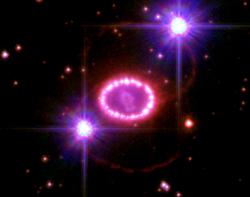 Only 20 years ago, astronomers were treated to one of the most powerful nearby explosions – a sight not seen in 400 years, before the advent of modern telescopes. What we now call Supernova 1987A detonated in the Large Magellenic Cloud providing a wealth of data for astronomers. Okay, it actually detonated 163,000 years ago, but that’s how long it took the light to reach us.
Only 20 years ago, astronomers were treated to one of the most powerful nearby explosions – a sight not seen in 400 years, before the advent of modern telescopes. What we now call Supernova 1987A detonated in the Large Magellenic Cloud providing a wealth of data for astronomers. Okay, it actually detonated 163,000 years ago, but that’s how long it took the light to reach us.
Continue reading “20th Anniversary of the Brightest Supernova in Recent History”
Hubble View of Planetary Nebula NGC 2440
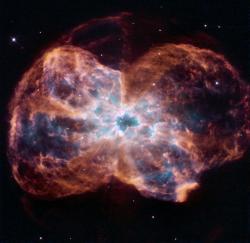 This beautiful photograph was captured by the Hubble Space Telescope’s Wide Field Planetary Camera 2, and it shows the planetary nebula NGC 2440. Once again, we’re looking at a haunting vision of the future that awaits our own Sun.
This beautiful photograph was captured by the Hubble Space Telescope’s Wide Field Planetary Camera 2, and it shows the planetary nebula NGC 2440. Once again, we’re looking at a haunting vision of the future that awaits our own Sun.
Continue reading “Hubble View of Planetary Nebula NGC 2440”
Distant Cluster of Galaxies Viewed by Hubble
 This beautiful picture is of a distant collection of galaxies called the Abell S0740 galaxy cluster, captured by the Hubble Space Telescope. It’s located more than 450 million light years away in the constellation Centaurus.
This beautiful picture is of a distant collection of galaxies called the Abell S0740 galaxy cluster, captured by the Hubble Space Telescope. It’s located more than 450 million light years away in the constellation Centaurus.
Continue reading “Distant Cluster of Galaxies Viewed by Hubble”
Hubble Sees An Extrasolar Planet’s Atmosphere
 Now here’s a feat. The Hubble Space Telescope was able to analyze the atmosphere of a gas giant planet orbiting another star.
Now here’s a feat. The Hubble Space Telescope was able to analyze the atmosphere of a gas giant planet orbiting another star.
Continue reading “Hubble Sees An Extrasolar Planet’s Atmosphere”
Hubble’s Main Camera is Offline, Maybe Permanently
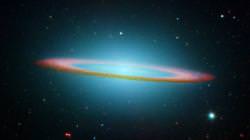 One of the Hubble Space Telescope’s main science instruments, the Advanced Camera for Surveys (ACS) has gone offline, and the chances of getting back online don’t look so good.
One of the Hubble Space Telescope’s main science instruments, the Advanced Camera for Surveys (ACS) has gone offline, and the chances of getting back online don’t look so good.
Continue reading “Hubble’s Main Camera is Offline, Maybe Permanently”
Hubble Sees a Hypergiant Star Nearing Death
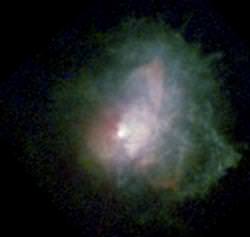 VY Canis Majoris, located about 5,000 light-years away, is no ordinary star; it’s a supergiant, containing 30 to 40 times the mass of our own Sun. And it’s so luminous it’s also considered a hypergiant, shining 500,000 times as bright as the Sun. And it’s big… really big. If this star lived in our Solar System, its surface would extend out to the orbit of Saturn.
VY Canis Majoris, located about 5,000 light-years away, is no ordinary star; it’s a supergiant, containing 30 to 40 times the mass of our own Sun. And it’s so luminous it’s also considered a hypergiant, shining 500,000 times as bright as the Sun. And it’s big… really big. If this star lived in our Solar System, its surface would extend out to the orbit of Saturn.
Continue reading “Hubble Sees a Hypergiant Star Nearing Death”
Hubble Helps Make a 3-D Map of Dark Matter
 A team of astronomers has created a three-dimensional map of dark matter distribution across the Universe. This map gives some of the best evidence that normal matter, like you and me, stars and planets, accumulate around the densest regions of dark matter.
A team of astronomers has created a three-dimensional map of dark matter distribution across the Universe. This map gives some of the best evidence that normal matter, like you and me, stars and planets, accumulate around the densest regions of dark matter.
Continue reading “Hubble Helps Make a 3-D Map of Dark Matter”
Happy Hubble Holidays
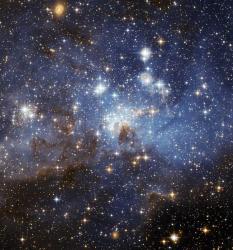 The fine folks at the Hubble Space Telescope released this photograph today to celebrate the holidays. I’m not sure which holiday specifically, but anytime is a good time to release beautiful new photographs from Hubble.
The fine folks at the Hubble Space Telescope released this photograph today to celebrate the holidays. I’m not sure which holiday specifically, but anytime is a good time to release beautiful new photographs from Hubble.
Continue reading “Happy Hubble Holidays”
Heavy Stars Embedded in NGC 6357
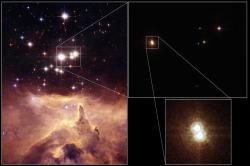 This Hubble photograph shows star cluster Pismis 24, which lies at the heart of emission nebula NGC 6357. The stars are some of the most massive ever seen in our galaxy, each of which weighs at least 100 times the mass of our Sun. Astronomers originally thought it was two stars, each of which exceeded the theoretical limits on stellar size. Hubble discovered that it’s actually three stars, bringing the reality back in line with theory.
This Hubble photograph shows star cluster Pismis 24, which lies at the heart of emission nebula NGC 6357. The stars are some of the most massive ever seen in our galaxy, each of which weighs at least 100 times the mass of our Sun. Astronomers originally thought it was two stars, each of which exceeded the theoretical limits on stellar size. Hubble discovered that it’s actually three stars, bringing the reality back in line with theory.
Continue reading “Heavy Stars Embedded in NGC 6357”
